Dynamic characteristics of turbomachinery
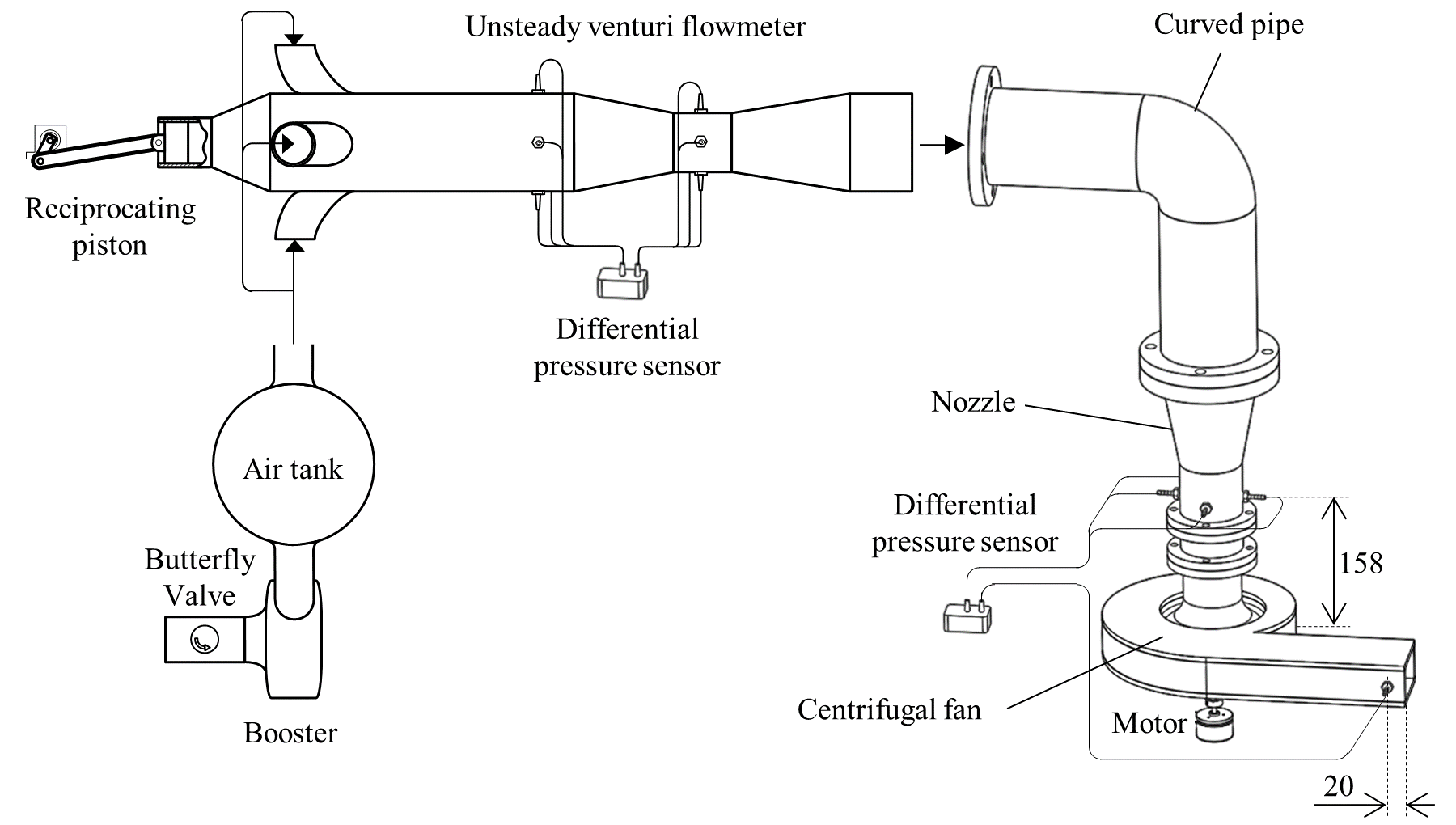 Under unsteady operating conditions in turbomachinery, the performance is unable to respond rapidly enough to follow characteristic curves for the steady condition. To design a reliable turbomachinery under unexpected unsteady conditions, we evaluated the dynamic transfer matrix of a three-dimensional centrifugal impeller. In this study, the transfer matrix for the three-dimensional centrifugal impeller could be effectively approximated through a first-order lag approximation considering a series-connected derivative system.
(Kambayashi & Kang, Journal of Fluids Engineering, 2024)
Under unsteady operating conditions in turbomachinery, the performance is unable to respond rapidly enough to follow characteristic curves for the steady condition. To design a reliable turbomachinery under unexpected unsteady conditions, we evaluated the dynamic transfer matrix of a three-dimensional centrifugal impeller. In this study, the transfer matrix for the three-dimensional centrifugal impeller could be effectively approximated through a first-order lag approximation considering a series-connected derivative system.
(Kambayashi & Kang, Journal of Fluids Engineering, 2024)
Estimation for dynamic characteristics of cavitating pump
 Cavitation instabilities are important when designing reliable turbo pumps for rocket engines. Based on linear stability analysis for cavitation instabilities, the dynamic characteristics for a cavitating pump, such as cavitation compliance, mass flow gain factor, pressure gain, and flow gain, are closely related to cavitation instabilities. The present research numerically evaluated the dynamic characteristics for a cavitating pump in a two-dimensional cascade flow using dynamic mode decomposition control (DMDc).
(Maruyama & Kang, et al., Journal of Fluids Engineering, 2025)
Cavitation instabilities are important when designing reliable turbo pumps for rocket engines. Based on linear stability analysis for cavitation instabilities, the dynamic characteristics for a cavitating pump, such as cavitation compliance, mass flow gain factor, pressure gain, and flow gain, are closely related to cavitation instabilities. The present research numerically evaluated the dynamic characteristics for a cavitating pump in a two-dimensional cascade flow using dynamic mode decomposition control (DMDc).
(Maruyama & Kang, et al., Journal of Fluids Engineering, 2025)
Digital twin of turbomachinery
 To conduct active control and detect anomalies in turbomachinery, it is crucial to monitor the internal flow field of turbomachinery in real-time. Typically, the internal flow field is acquired through Particle Image Velocimetry (PIV) or Computational Fluid Dynamics (CFD). However, these methods are time-consuming for analysis and calculation, posing challenges in obtaining real-time data on the internal flow field of turbomachinery. We propose an estimation method using Singular Value Decomposition (SVD) to estimate the internal flow field of turbomachinery. These estimation methods facilitate real-time assessment of the turbomachinery's internal flow field without the necessity of solving the Navier-Stokes equations during the estimation process.
(Kambayashi & Kang, Journal of Fluids Engineering, 2025)
To conduct active control and detect anomalies in turbomachinery, it is crucial to monitor the internal flow field of turbomachinery in real-time. Typically, the internal flow field is acquired through Particle Image Velocimetry (PIV) or Computational Fluid Dynamics (CFD). However, these methods are time-consuming for analysis and calculation, posing challenges in obtaining real-time data on the internal flow field of turbomachinery. We propose an estimation method using Singular Value Decomposition (SVD) to estimate the internal flow field of turbomachinery. These estimation methods facilitate real-time assessment of the turbomachinery's internal flow field without the necessity of solving the Navier-Stokes equations during the estimation process.
(Kambayashi & Kang, Journal of Fluids Engineering, 2025)
Inverse design for Turbomachinery
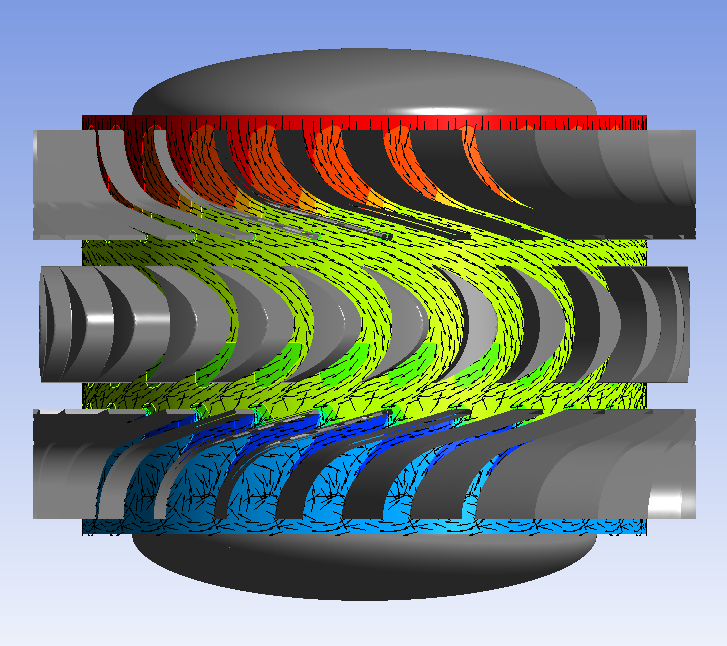 In wave power generation, the reciprocating airflow occurs due to the rise and fall of the water surface, resulting in the impulse turbine having symmetrical guide vanes on both sides of the rotor. In this study, we propose an inverse design method utilizing Gappy Proper Orthogonal Decomposition (Gappy POD) to optimize the turbine and guide vane geometries. To achieve the inverse design of a 3D impulse turbine, geometry data and performance data (input coefficients, torque coefficients, flow coefficients, efficiency, etc.) will be collected from both experiments and analyses. The optimization of the turbine and guide vane geometries will be performed based on the acquired learning data.
In wave power generation, the reciprocating airflow occurs due to the rise and fall of the water surface, resulting in the impulse turbine having symmetrical guide vanes on both sides of the rotor. In this study, we propose an inverse design method utilizing Gappy Proper Orthogonal Decomposition (Gappy POD) to optimize the turbine and guide vane geometries. To achieve the inverse design of a 3D impulse turbine, geometry data and performance data (input coefficients, torque coefficients, flow coefficients, efficiency, etc.) will be collected from both experiments and analyses. The optimization of the turbine and guide vane geometries will be performed based on the acquired learning data.
Unsteady flow around impeller with forward curved vanes
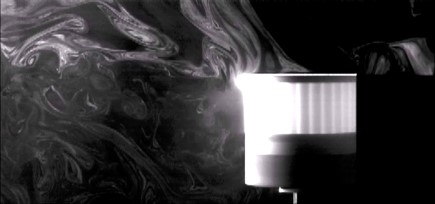 Upon observing the impeller with forward-curved vanes, we noted the presence of a rotating cell moving in the opposite direction to the impeller's rotation. This represents a unique fluid phenomenon. By visualizing this rotating cell, we aim to elucidate the mechanism governing its direction and speed. This phenomenon holds potential applications in various fluid machines, including ventilators and mixers.
Upon observing the impeller with forward-curved vanes, we noted the presence of a rotating cell moving in the opposite direction to the impeller's rotation. This represents a unique fluid phenomenon. By visualizing this rotating cell, we aim to elucidate the mechanism governing its direction and speed. This phenomenon holds potential applications in various fluid machines, including ventilators and mixers.
Water Entry Dynamics
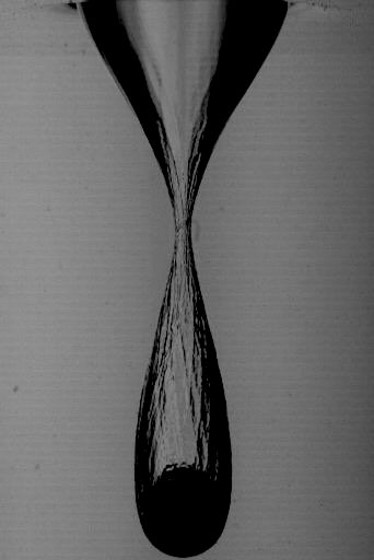 Water entry of a sphere is a classical problem that often offers striking fluid imageries. There has been a long history of research, and the dynamics of the single water entry cavity in free water space have been well understood (Rabbi & Kiyama, et al., J. Fluid Mech, 2021). Beyond this, we are working on the dynamics of a cavity under the influence of the surrounding boundaries. Understanding the fluid physics behind this might help us further depict the interfacial dynamics in not only the ocean engineering applications but also the animal diving behaviors.
Water entry of a sphere is a classical problem that often offers striking fluid imageries. There has been a long history of research, and the dynamics of the single water entry cavity in free water space have been well understood (Rabbi & Kiyama, et al., J. Fluid Mech, 2021). Beyond this, we are working on the dynamics of a cavity under the influence of the surrounding boundaries. Understanding the fluid physics behind this might help us further depict the interfacial dynamics in not only the ocean engineering applications but also the animal diving behaviors.
Water Drop Explosion in the Hot Cooking Oil
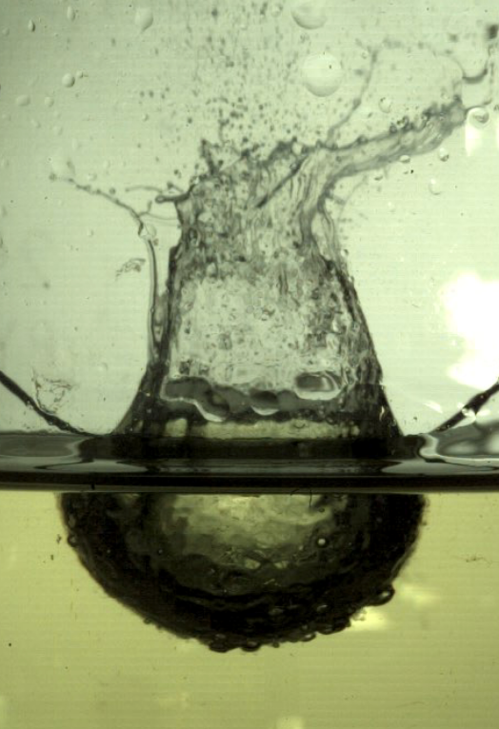 We often experience the spattering of the cooking oil when trying a deep-flying like Tempura. One of the violent causes of this event is the explosion of water spills. By simplifying the situation down to a water droplet explosion in a heated oil (Kiyama, et al., Phys. Fluids, 2022), we are trying to understand what the governing parameters of this short-lived fluid dynamic would be. We are also using the acoustic signals to classify the bubble behavior and even the aerosol characteristics.
We often experience the spattering of the cooking oil when trying a deep-flying like Tempura. One of the violent causes of this event is the explosion of water spills. By simplifying the situation down to a water droplet explosion in a heated oil (Kiyama, et al., Phys. Fluids, 2022), we are trying to understand what the governing parameters of this short-lived fluid dynamic would be. We are also using the acoustic signals to classify the bubble behavior and even the aerosol characteristics.
Active control of cavitation surge in hydraulic system
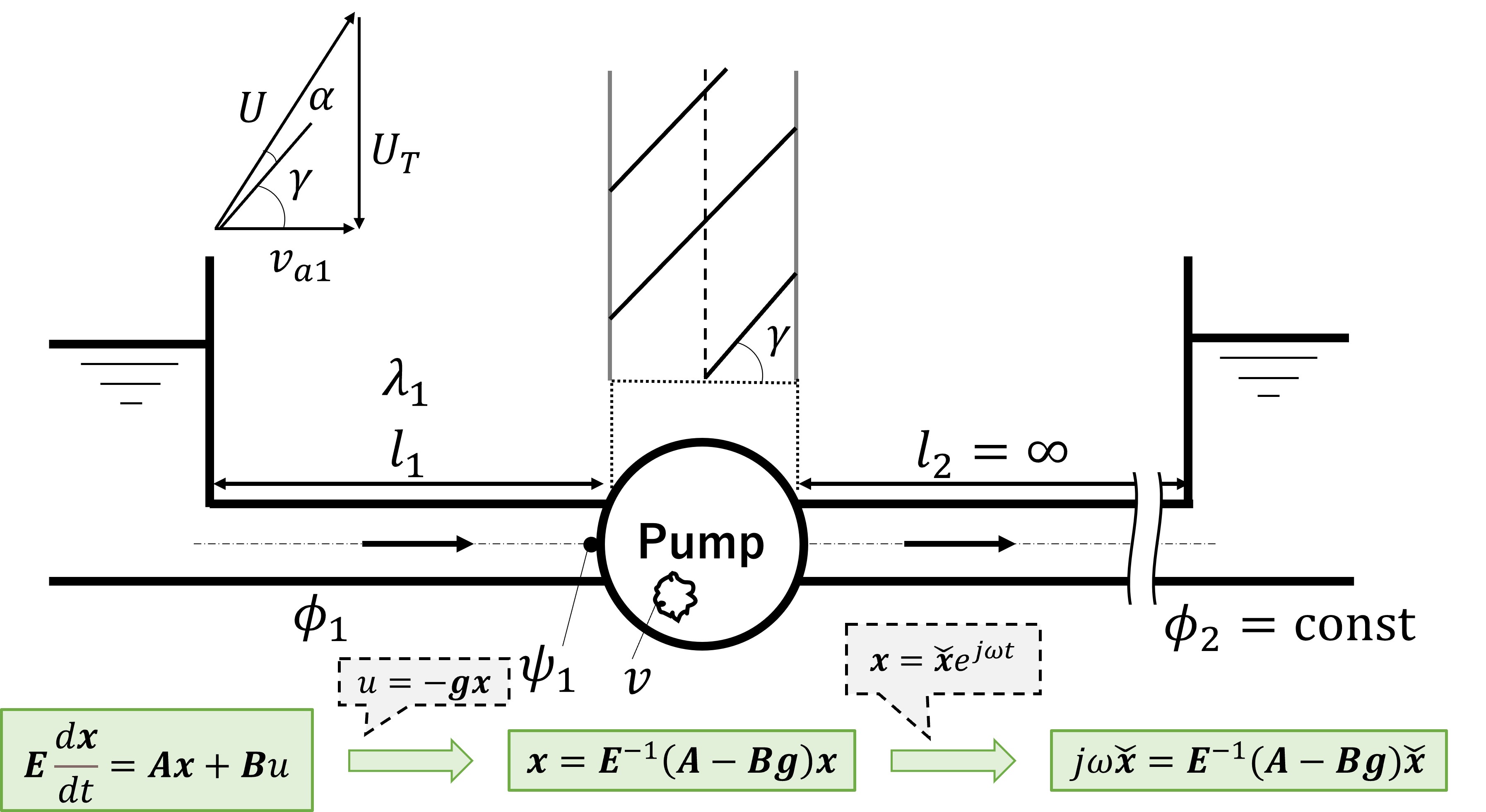 In the 1960s, during rocket launches, a longitudinal vibration known as POGO instability occurred, resulting in launch failures. This instability is closely linked to cavitation instabilitiess. In this study, we propose and assess linear and non-linear active control models for managing cavitation surge. Unlike passive methods, active control offers the ability to suppress cavitation surge without sacrificing performance at the design operating condition.(Kang, et al., IJFMS, 2023)
In the 1960s, during rocket launches, a longitudinal vibration known as POGO instability occurred, resulting in launch failures. This instability is closely linked to cavitation instabilitiess. In this study, we propose and assess linear and non-linear active control models for managing cavitation surge. Unlike passive methods, active control offers the ability to suppress cavitation surge without sacrificing performance at the design operating condition.(Kang, et al., IJFMS, 2023)
Active control of flow separation
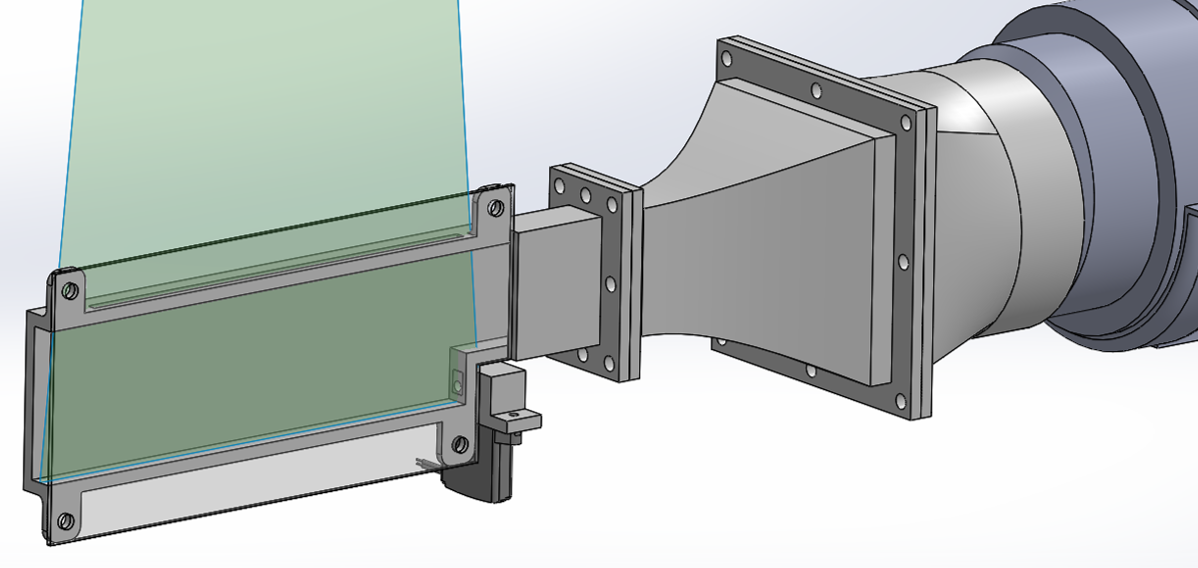 In this study, we utilize dynamic mode decomposition with control (DMDc) to analyze a separated flow in an enlarged rectangular pipe and to develop a feedback control system. Although DMDc can transform a nonlinear system into a linear one, if it accurately captures the flow field dynamics as a linear model, it holds the potential to control fluid system.
In this study, we utilize dynamic mode decomposition with control (DMDc) to analyze a separated flow in an enlarged rectangular pipe and to develop a feedback control system. Although DMDc can transform a nonlinear system into a linear one, if it accurately captures the flow field dynamics as a linear model, it holds the potential to control fluid system.
Construction of a digital twin for hydrogen generation reactor
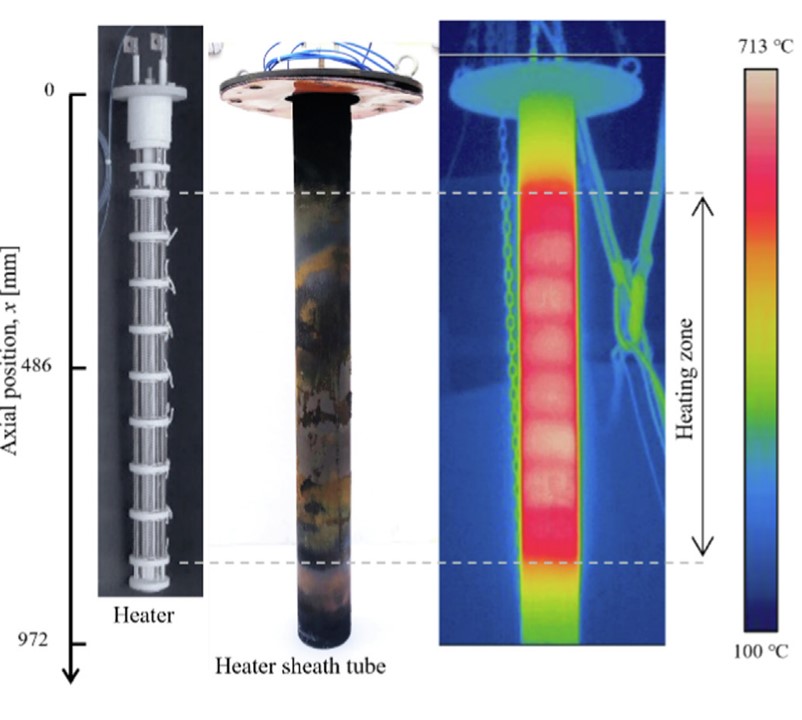 The hydrogen production reactor environment, via methane direct decomposition, presents a heightened risk of explosion owing to elevated temperature and pressure. However, there's a dearth of research evaluating its safety and potential explosion scale. Consequently, ensuring proper safety management is imperative for reactor operation. Nevertheless, due to the specialized nature of the reactor's environment, assessing temperature distribution and predicting hazards in three dimensions proves challenging, often restricted to point measurements. Thus, to establish an effective safety management system, comprehending the internal state from these limited point measurements becomes crucial. Consequently, we construct a digital twin of the actual reactor in cyberspace, leveraging point datasets obtained through physical experimentation.
The hydrogen production reactor environment, via methane direct decomposition, presents a heightened risk of explosion owing to elevated temperature and pressure. However, there's a dearth of research evaluating its safety and potential explosion scale. Consequently, ensuring proper safety management is imperative for reactor operation. Nevertheless, due to the specialized nature of the reactor's environment, assessing temperature distribution and predicting hazards in three dimensions proves challenging, often restricted to point measurements. Thus, to establish an effective safety management system, comprehending the internal state from these limited point measurements becomes crucial. Consequently, we construct a digital twin of the actual reactor in cyberspace, leveraging point datasets obtained through physical experimentation.
Laser-induced Cavitation
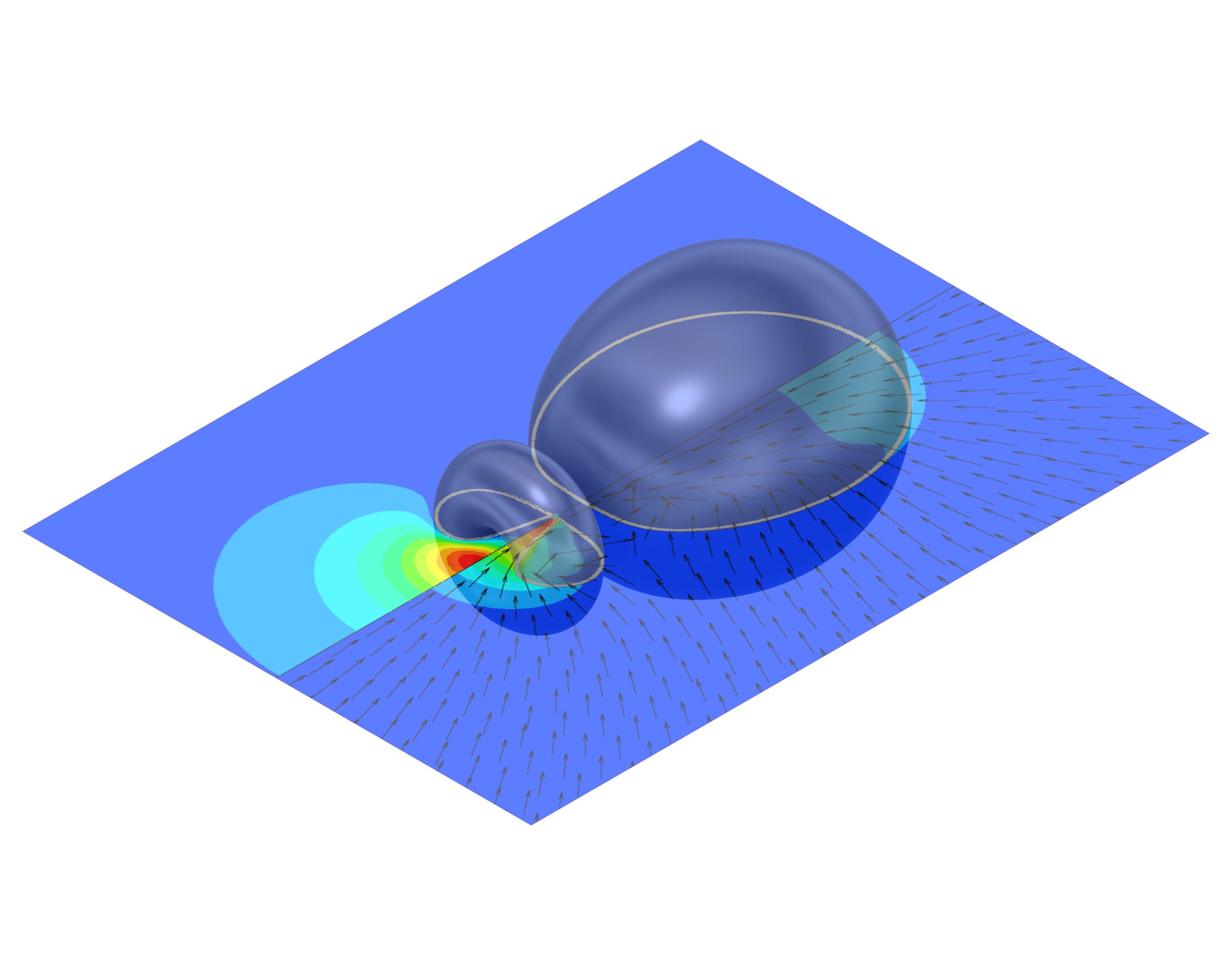 Cavitation can occur when liquid experiences sudden pressure reduction. Alternatively, bubble formation upon local heating such as optical breakdown is widely used to study the fundamental bubble dynamics. We are especially interested in the bubble behavior in which the interaction with the surrounding boundary is at play. Find out more about our recent developments on the bubble near another bubble (Terasaki, et al., Phys. Fluids, 2024) or the combined boundaries (Kiyama, et al., Phys. Rev. Fluids, 2021).
Cavitation can occur when liquid experiences sudden pressure reduction. Alternatively, bubble formation upon local heating such as optical breakdown is widely used to study the fundamental bubble dynamics. We are especially interested in the bubble behavior in which the interaction with the surrounding boundary is at play. Find out more about our recent developments on the bubble near another bubble (Terasaki, et al., Phys. Fluids, 2024) or the combined boundaries (Kiyama, et al., Phys. Rev. Fluids, 2021).
Soft Impact
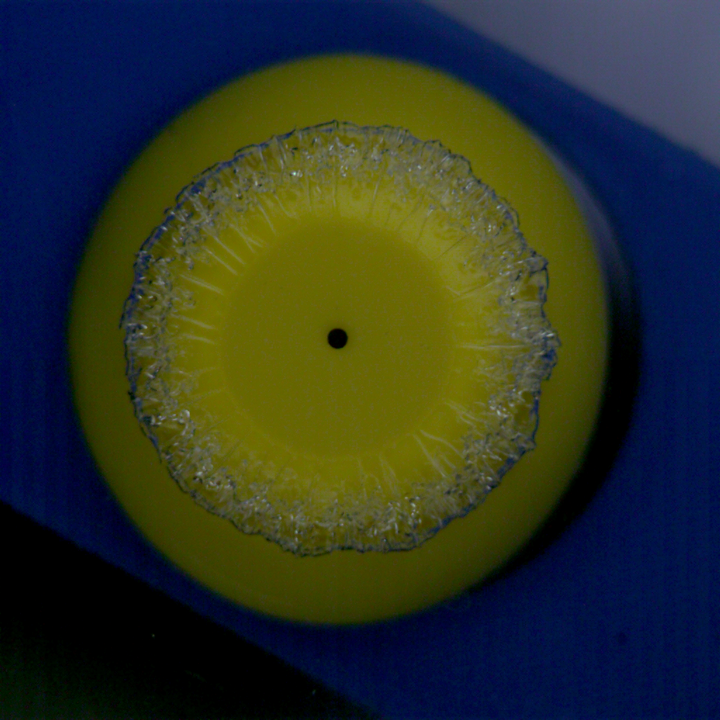 Cavitation can also occur when sudden acceleration is imposed to the liquid. We can observe the formation of bubbles by hitting a water-filled bottle (Pan & Kiyama, et al., Proc. NAS, 2017) or by even slamming a rigid wall submerged underwater with a snapping popper toy (Kiyama, et al., submitted). With the help of high-speed imaging and other sensing techniques, we keep exploring unique ways to cavitate liquid!
Cavitation can also occur when sudden acceleration is imposed to the liquid. We can observe the formation of bubbles by hitting a water-filled bottle (Pan & Kiyama, et al., Proc. NAS, 2017) or by even slamming a rigid wall submerged underwater with a snapping popper toy (Kiyama, et al., submitted). With the help of high-speed imaging and other sensing techniques, we keep exploring unique ways to cavitate liquid!
Impinging jet to perforated plates
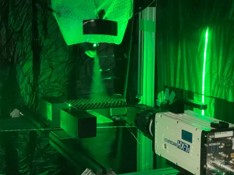 To reduce the safety distance at hydrogen stations, the installation of porous plates is being considered. Porous plates are attracting attention for their ability to simultaneously reduce the broad diffusion of hydrogen jets and suppress stagnation, and there is a need to establish equations predicting jet velocity through porous plates as a function of parameters. In this study, estimation of velocity deficit of jets using resistance measurements with load cells is conducted. Additionally, visualization and velocity measurements of jets colliding with porous plates using Particle Image Velocimetry (PIV) are performed to elucidate the mechanism of momentum deficit caused by porous plates. The objective of this study is to derive equations predicting jet velocity through porous plates.
To reduce the safety distance at hydrogen stations, the installation of porous plates is being considered. Porous plates are attracting attention for their ability to simultaneously reduce the broad diffusion of hydrogen jets and suppress stagnation, and there is a need to establish equations predicting jet velocity through porous plates as a function of parameters. In this study, estimation of velocity deficit of jets using resistance measurements with load cells is conducted. Additionally, visualization and velocity measurements of jets colliding with porous plates using Particle Image Velocimetry (PIV) are performed to elucidate the mechanism of momentum deficit caused by porous plates. The objective of this study is to derive equations predicting jet velocity through porous plates.
Thrust and transport Characteristics of Synthetic Jets
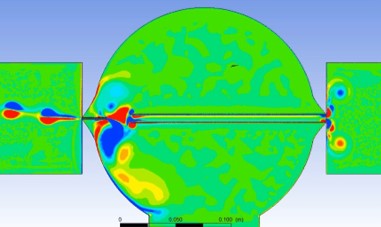 A synthetic jet is a jet flow that generates a time-averaged thrust despite the mass flow rate near the slot being zero, by alternately ejecting and suctioning fluid. Various actuation methods have been proposed for synthetic jet actuators, all of which excel in miniaturization and weight reduction due to their minimal mechanical driving components. Conventional synthetic jets are generated from a single slot installed in one direction, capable of producing thrust only in one direction. In this study, a model with nozzles installed axisymmetrically, each with different generation conditions, enables the generation of thrust in both directions, leading to improved fluid control performance.
A synthetic jet is a jet flow that generates a time-averaged thrust despite the mass flow rate near the slot being zero, by alternately ejecting and suctioning fluid. Various actuation methods have been proposed for synthetic jet actuators, all of which excel in miniaturization and weight reduction due to their minimal mechanical driving components. Conventional synthetic jets are generated from a single slot installed in one direction, capable of producing thrust only in one direction. In this study, a model with nozzles installed axisymmetrically, each with different generation conditions, enables the generation of thrust in both directions, leading to improved fluid control performance.
Urinary flow rate estimation using sparse singular value for portable urinary flow measurement devices
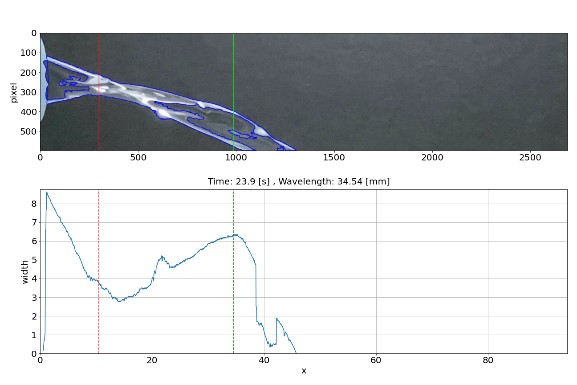 This study aims to diagnose urinary disorders early by attempting portable urine flow measurement from urinary images and sound data. The liquid column exhibits a twisting shape where the long and short axes of the liquid column cross, observed as an Axis Switching phenomenon. It is known that the length of this Axis Switching wavelength (AS wavelength) correlates with flow rate. In this study, the Gappy POD method was used to estimate urine flow rate from both urinary images and sound.
This study aims to diagnose urinary disorders early by attempting portable urine flow measurement from urinary images and sound data. The liquid column exhibits a twisting shape where the long and short axes of the liquid column cross, observed as an Axis Switching phenomenon. It is known that the length of this Axis Switching wavelength (AS wavelength) correlates with flow rate. In this study, the Gappy POD method was used to estimate urine flow rate from both urinary images and sound.
